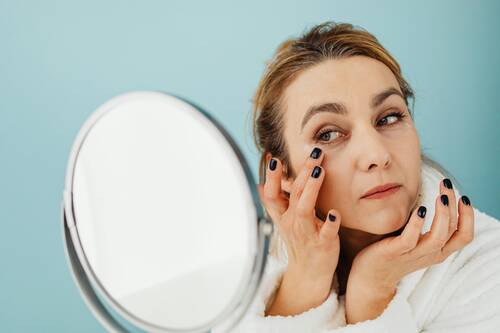
29 Oct Exploring Modern Solutions for Aging Skin
As time goes on, the skin naturally undergoes changes—fine lines, wrinkles, and a loss of elasticity are all part of the aging process. While aging is a natural and beautiful aspect of life, modern skincare offers a wide range of solutions to help maintain a youthful glow. From advanced ingredients to cutting-edge treatments, understanding these options can empower you to make choices that support your skin’s health and appearance. Here, we explore the most effective modern solutions for aging skin and how they work to rejuvenate your complexion.
- Retinoids: The Gold Standard for Anti-Aging
Retinoids, derivatives of vitamin A, remain one of the most effective and widely studied ingredients for combatting signs of aging. They work by boosting cell turnover, encouraging the production of new skin cells, and stimulating collagen synthesis. This clever process helps reduce the appearance of fine lines, wrinkles, and uneven skin tone.
If you are pregnant, nursing or planning to become pregnant, please consult with your health care provider before using retinoids.
How to Use Retinoids:
- Begin your routine with a low concentration to allow your skin to adjust, such as over-the-counter retinol.
- Use retinoids at night, as they can make the skin more sensitive to sunlight.
- Moisturize thoroughly to counteract any dryness or irritation that may occur during initial use.
- Hyaluronic Acid: Deep Hydration for Plumper Skin
As we age, the skin’s ability to retain moisture diminishes, leading to dryness and a loss of plumpness. Hyaluronic acid (HA) is a powerful humectant that can hold up to 1,000 times its weight in water, making it a go-to ingredient for hydration. By binding moisture to the skin, HA helps to smooth out fine lines and give the skin a firmer, more youthful appearance.
How to Incorporate Hyaluronic Acid:
- Apply a hyaluronic acid serum immediately after cleansing while the skin is still damp.
- Follow this step with a rich moisturizer to lock in the hydration.
- Look for multi-molecular weight HA formulations for deeper penetration and longer-lasting hydration.
- Peptides: Building Blocks for Firm Skin
Peptides are short chains of amino acids that act as the building blocks of proteins like collagen and elastin, which are vital for skin strength and elasticity. As we age, collagen production naturally slows, leading to sagging skin and wrinkles. Peptides in skincare products can help stimulate the skin to produce more much-needed collagen, resulting in improved firmness and elasticity.
How to Use Peptides:
- Incorporate peptide serums into your daily routine to target areas prone to sagging.
- Use peptide-infused eye creams to help reduce crow’s feet and firm the delicate skin around the eyes.
- Pair peptides with antioxidants, such as vitamin C, for enhanced collagen support.
- Antioxidants: Defending Against Environmental Damage
Oxidative stress from pollution, UV radiation, and other environmental factors accelerate the aging process by breaking down collagen and elastin. Antioxidants, including vitamin C, vitamin E, and niacinamide, help neutralize free radicals that cause damage to the skin. These ingredients brighten the complexion, reduce dark spots, and support the skin’s natural repair processes.
How to Incorporate Antioxidants:
- Use a vitamin C serum in the morning to protect against daily environmental stressors.
- Combine antioxidant serums with sunscreen to boost their protective effects.
- Consider products with multiple antioxidants for a comprehensive defense against aging.
- Non-Invasive Cosmetic Treatments: Quick Results with Minimal Downtime
Modern cosmetic treatments offer non-invasive options that can provide faster results for those looking to address deeper wrinkles, sagging skin, or loss of volume. These treatments typically require little to no downtime, making them popular among those with busy lifestyles.
Popular Non-Invasive Treatments:
- Botox and Dermal Fillers: Botox temporarily relaxes muscles that cause wrinkles, while fillers add volume to areas like the cheeks and lips.
- Laser Resurfacing: Lasers can target pigmentation, smooth fine lines, and improve overall skin texture by stimulating collagen production.
- Microneedling: This technique uses tiny needles to create micro-injuries in the skin, encouraging collagen and elastin production for firmer skin.
- Surgical Solutions: A Long-Term Approach to Aging Skin
For more dramatic results, surgical procedures can provide long-lasting improvements. Blepharoplasty, or eyelid surgery, is a popular choice for addressing sagging skin around the eyes, creating a more refreshed appearance. This procedure can significantly reduce puffiness, under-eye bags, and drooping eyelids that often accompany aging. Learn more about blepharoplasty Cambridge options for those looking to rejuvenate their eye area.
Benefits of Surgical Solutions:
- Can address deeper wrinkles and significant skin laxity.
- Often provides more noticeable and longer-lasting results.
- Best for individuals seeking a more dramatic transformation with a willingness to invest in a recovery period.
Final Takeaways
Aging skin deserves care and attention, and with modern solutions, it’s possible to maintain a vibrant, youthful appearance. Whether you prefer topical treatments, non-invasive procedures, or advanced skincare formulations, there is an option to suit every need. By staying informed and choosing the right approach, you can embrace the aging process while keeping your skin looking and feeling its best. With a balanced regimen and professional guidance, aging skin can remain healthy, radiant, and resilient.
——————
The information on MedicalResearch.com is provided for educational purposes only, and is in no way intended to diagnose, cure, or treat any medical or other condition.
Some links are sponsored. Products and services are not tested, warranted or endorsed.
Always seek the advice of your physician or other qualified health and ask your doctor any questions you may have regarding a medical condition. In addition to all other limitations and disclaimers in this agreement, service provider and its third party providers disclaim any liability or loss in connection with the content provided on this website.
Last Updated on October 29, 2024 by Marie Benz MD FAAD
